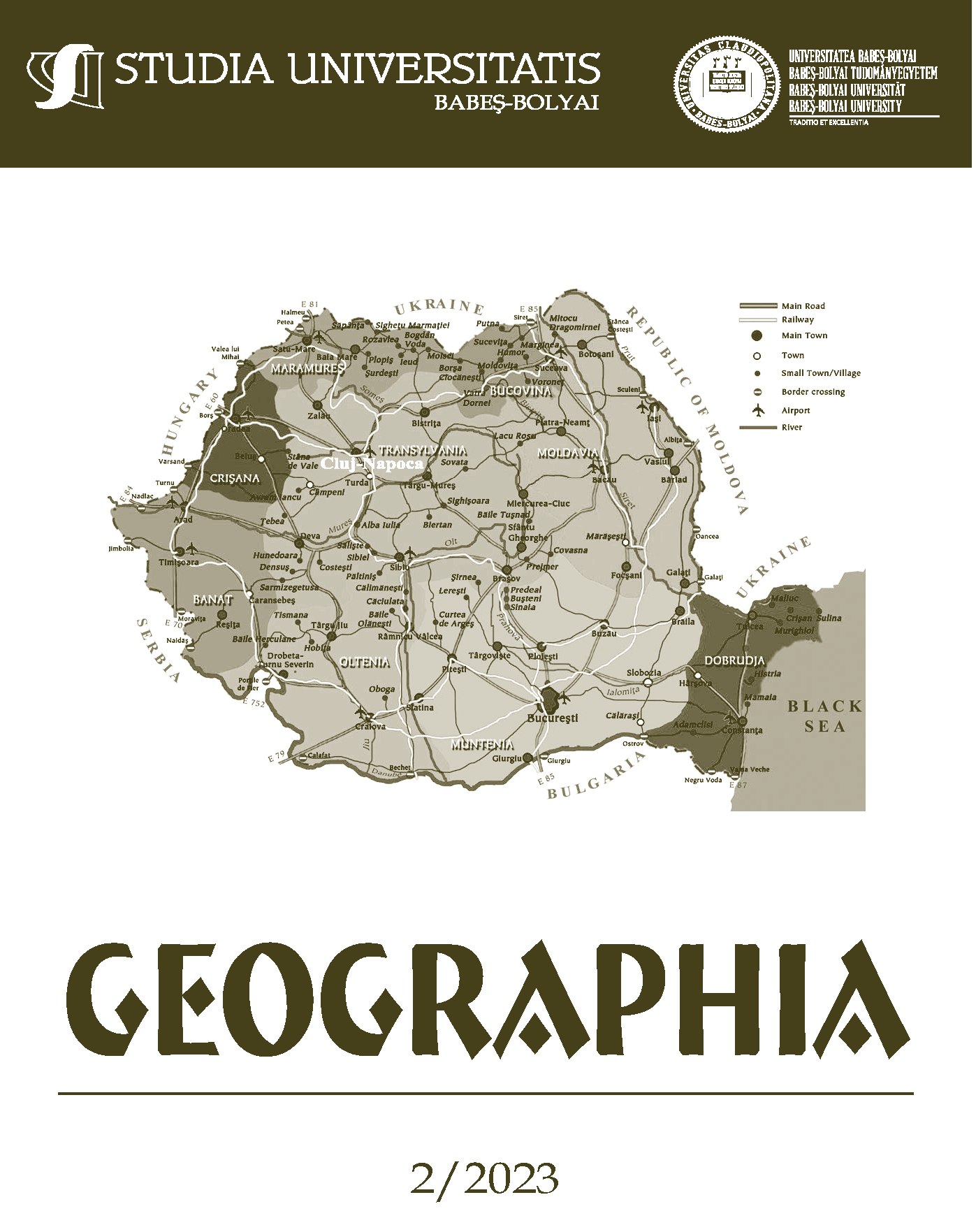Anthropogenic Hazards and Their Impact Upon the Historical Cultural Landscape in Roșia Montană Area
DOI:
https://doi.org/10.24193/subbgeogr.2023.2.03Keywords:
Roșia Montană, cultural landscape, historical cultural landscape, anthropogenic hazards, mining, gold deposits.Abstract
The cultural landscape is a result of the continuous human actions of satisfying the communities’ various needs and the response of the natural system, in its attempt to balance its components in relation to the modelling factor - the human society. Thus, the cultural landscape displays the imprint of the infinite possibilities of the human and natural joint manifestation, sometimes hazards bringing their own contribution to the shaping of the cultural landscape. Hazards, whether natural or anthropogenic, are unforeseen phenomena in terms of space or time of their manifestation, and most often have considerable negative consequences. In particular, anthropogenic hazards, which are directly or indirectly related to human activities, appear mainly as a manifestation of the resilience of natural elements in the cultural landscape, as a complex system. Thus, major interventions, such as mining in Roșia Montană area (an activity that had been lasting for over 2000 years) in relation to the unpredictable evolution of the social, economic, technological and political context (on local, national and global level) have favoured the manifestation of some unforeseen events with a negative connotation such as: complex pollution, depreciation of the living standards (in Roșia Montană area mostly due to the cessation of mining activities), demographic aging, etc. The complex analysis of these implications in the above mentioned area allows us to outline an eloquent assessment of the present state of the local cultural landscape and to identify the opportunities of systemic resilience. These include: the awareness of the planning, protection and conservation of the local historical cultural landscape as a primary need, restoration of the cultural landscape (through the aesthetic rehabilitation of degraded cultural elements), the implementation of projects that target the sustainable development of Roșia Montană, as a source of identity and sustainable development, the tourism conversion of activities, etc.References
Akeroyd, J. R. (2012), The Botanical and Anthropogenic Landscape of Roșia Montană, in: Roșia Montană in Universal History, Presa Universitară Clujeană/Cluj University Press, Cluj-Napoca.
Albu Alina, Satmari Alina, Despi Alina, Albu, B., Aatmari, l., Cengher, P., cu sprijinul d-lui E. Cornea (2007), Strategie Alternativă pentru o Dezvoltare Durabilă în Roşia Montană.
Apostol, V., Bâlici, Șt. (2012), Roșia Montană: An assessment of the cultural heritage, in: Roșia Montană in Universal History, Presa Universitară Clujeană/Cluj University Press, Cluj-Napoca.
Büttner, Th. (2006), Verwilderndes Land – wuchernde Stadt? Die Zukunft der Kulturlandschaft. Zum Kulturlandschaftsbegriff – seine Herleitung und Verwendung in Theorie und Praxis, Universität Kassel. (Source: http://www.naturathlon.eu/fileadmin/MDB/documents/service/perspektivekultur_buettner.pdf, last accessed on 01.03.2022).
Ciangă, N., Bolog Cristina (2012), Tourism-Coordinate of a Long-Term Sustainable Development in the Roșia Montană Area, in: Roșia Montană in Universal History, Presa Universitară Clujeană/Cluj University Press, Cluj-Napoca.
Duma, S. (2012), The Impact of Mining on Environment at Roșia Montană, in: Roșia Montană in Universal History, Editura Presa Universitară Clujeană/Cluj University Press, Cluj-Napoca. (The author states: ,,The present article was published in Analele Universității din București. Geografie, 2008, pp. 75-88, under the title Gold and Environment at Roșia Montană. Realities and Perspectives).
Gavra, Camelia-Ina (2013), Peisaje culturale în Munții Metaliferi, Editura Risoprint, Cluj-Napoca.
Gligor, V. (2012), Natural Reserves and the Biodiversity of Roșia Montană Area, in Roșia Montană in Universal History, Presa Universitară Clujeană/Cluj University Press, Cluj-Napoca.
Hărmănescu, Mihaela A. (2015), Patrimoniu şi peisaj rural. Strategii de integrare şi promovare, Edit. Muzeul Literaturii Române, București.
Ianovici, V., Borcoș, M., Bleahu, M., Patrulius, D., Lupu, M., Dimitrescu, R., Savu, H. (1976), Geologia Munților Apuseni, Edit. Academiei RSR, București.
Kaya, Latif Gürkan (2002), Cultural landscape for tourism, - Online available at: https://dergipark.org.tr/tr/download/article-file/40137.
Mac, I., Petrea, D. (2002), Polisemia evenimentelor geografice extreme, in: Riscuri și catastrofe, Edit. Casa Cărții de Știință, Cluj-Napoca.
Moldovan, F., Croitoru, Adina-Eliza, Holobâcă, I.-H. (2012), General Climate Conditions in Roșia Montană Area, in: Roșia Montană in Universal History, Presa Universitară Clujeană/Cluj University Press, Cluj-Napoca.
Morariu, T., Bogdan, Octavia, Maier, A. (1980), Județul Alba, Edit. Academiei RSR, București.
Olaru-Zăinescu, Sorana (2006), Dezvoltare durabilă alternativă mineritului la Roşia Montană, Analiza resurselor şi elemente de strategie, Asociaţia Alburnus Maior.
Roșian, Gh. (2011), Geomorfologia Mediului, Edit. Presa Universitară Clujeană, Cluj-Napoca.
Sântimbrean, A., Bedelean, H. (2004), Roșia Montană Alburnus Maior, Cetatea de scaun a aurului românesc, Ediția a II-a, Editura Altip, Alba.
Sântimbrean, A., Bedelean, H., Bedelean Aura (2009), Aurul și argintul Roșiei Montane, Ediția a II-a, Editura Altip, Alba Iulia.
Tanislav, D., Costache, Andra (2007), Geografia hazardelor naturale și antropice, Edit. Transversal, Târgoviște.
Vasiliță-Crăciun, Ileana-Cristina (2015), Peisajul cultural industrial și necesitatea protejării sale. Studiu de caz: Roșia Montană, Geographia Napocensis, IX, nr. 2, Casa Cărții de Știință, Cluj-Napoca.
***ECOVAST, 2006: (European Council for the Village and Small Town), Landscape Identification guide. A guide to good practice. (Source: http://ecovast.org/papers/good_guid_corr_e.pdf, last accessed on 15.11.2022).
***Dicționarul explicativ al limbii române, DEX, (1975), Edit. Academiei Republicii Socialiste România, București.
***Raport pentru evaluarea impactului asupra mediului: Studiu de condiţii iniţiale asupra patrimoniului cultural. Întocmit de: STANTEC CONSULTING (Source: https://www.rmgc.ro/Content/uploads/uploads_eia/impactul-potential/cultura-patrimoniu/04.9-Studiu-de-conditii-initiale-asupra-patrimoniului.pdf, last accessed on 02.09.2022).
***Partea I, Plan de management pentru Patrimoniul Arheologic din zona Roșia Montană, S.C. Roșia Montană Gold Corporation S.A. - Raport la studiul de evaluare a impactului asupra mediului. (Source: https://www.rmgc.ro/Content/uploads/uploads_eia/impactul-potential/cultura-patrimoniu/Plan-de-management-al-patrimoniului-cultural-Arheologie.pdf, last accessed on 14.09.2022).
Downloads
Published
How to Cite
Issue
Section
License
Copyright (c) 2023 Studia Universitatis Babeș-Bolyai Geographia

This work is licensed under a Creative Commons Attribution-NonCommercial-NoDerivatives 4.0 International License.





 ©Studia Universitatis Babeş-Bolyai Geographia. Published by Babeș-Bolyai University.
©Studia Universitatis Babeş-Bolyai Geographia. Published by Babeș-Bolyai University.